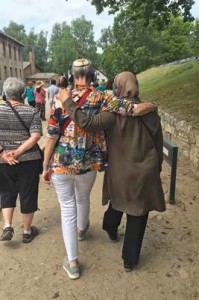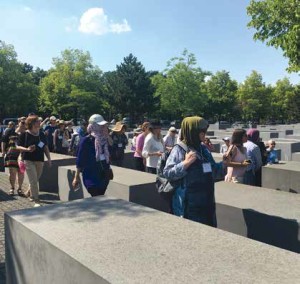Tag : Auschwitz
January 26, 2021 by admin
Virtual Field Trips
Manhattan’s Museum of the Jewish Heritage offers a free Holocaust curriculum for
teachers at all school levels using recorded field trips. Special programs include
“Meeting Hate with Humanity: Life During the Holocaust” that utilizes the museum’s exhibition “Auschwitz. Not long ago. Not far away.” to teach about Jewish life before, during and after the Holocaust. “Love Thy Neighbor: Immigration and the U.S. Experience” foregrounds items from the Jewish immigrant experience. Professional development for teachers is also accessible from the Museum’s Education Department.
mjhnyc.org/education
- No Comments
June 25, 2020 by admin
Finding Else Ury’s Suitcase at Auschwitz
When I was a child in Germany in the 1930s, Else Ury was the most popular author of children’s books, credited with close to forty publications. Her most popular series of books was Nesthaekchen, or Fledgling, a detailed ten-volume chronicle. The books were best-sellers, eagerly read by children growing up in the turbulent days of Hitler’s rise to power.
My girlfriends and I, Jewish and non-Jewish, passed the volumes among us, making sure that we had not omitted a single one. While the first volume dealt with Nesthaekchen’s life in the nursery with her dolls and toys, succeeding books took the reader through her first school year, her stay in a children’s home, her teens, marriage, motherhood and finally grand motherhood.
The narrative was uncomplicated, the adventures innocent yet appealing. What drew us to the stories? Most of us could hardly identify with the little girl with blond curls and blue eyes who lived in an affluent home. We felt that our world was no longer secure. Life had changed for the girls in Hitler’s Germany We were aware of the marching brown shirts and the growing anti-Semitism. Gentile girls were coerced into wearing the uniform of the Hitler Youth and were taught loyalty to the swastika above obedience to family.
Our lives were a far cry from the life described by Else Ury. Her books were non-political and non-denominational. Few people knew that she was Jewish.
In May of 1933, when the Nazis were ordered to burn all books by Jewish authors, hers were surely among them. Unlike other writers, such as Thomas and Heinrich Mann, Stefan Zweig and Berthold Brecht, she did not flee Germany She remained in Berlin until January 12,1943, when she was deported to Auschwitz with one of the last groups of Jews to leave the city She was sixty-six years old. The Gedenkbuch—an extensive listing of all West German Jews who perished in the Holocaust—lists her simply as verschollen, disappeared.
Recently, an interest in Else Ury has surfaced in Germany her works are being reissued by Hoch Verlag and Stuttgart, and the Heimatmuseum—a local museum in the area where she lived in Berlin—has devoted an exhibit to her.
An article in a Berlin newspaper. Das Tageblatt, provides more news. Students from a high school in the suburbs of Berlin, decided— after seeing “Schindler’s List”—to visit Auschwitz. There they obtained a list of Berlin residents who perished in the gas chambers. A group of girls made it their goal to inform the next-of-kin of the death dates of their family members, and Else Ury’s name struck a chord with the students. They found out that the author had died on the day of her arrival at the death camp, and to their surprise, they discovered her suitcase among the confiscated properties of the victims. It was marked with her name and the compulsory addition of “Sara.”
It pleases me that Else Ury is coming into her own again after close to sixty years. I only regret that the German publisher failed to note on the cover that the author was killed at Auschwitz because she was Jewish. Even as growing girls continue to enjoy the books by Louisa May Alcott and Johanna Spyri, we dare not forget the times still in the memory of those alive, when an author and her books were consigned to the flames.
Anne L. Fox was born in Berlin and lives in Merion, Pennsylvania. Her most recent book, My Heart in a Suitcase (Valentine Mitchell, 1996), is a memoir of her life in England during the war.
- No Comments
January 16, 2020 by admin
After Auschwitz, They Never Forgot Each Other
The reunion lasted about two hours. He finally had to ask: Did she have something to do with the fact that he’d managed to survive in Auschwitz all that time?
She held up her hand to display five fingers. Her voice was loud, her Slovakian accent deep. “I saved you five times from bad shipment,” she said.
“I knew she would do that,” said Mr. Wisnia to his grandchildren. “It’s absolutely amazing. Amazing.”
There was more. “I was waiting for you,” Ms. Tichauer said. Mr. Wisnia was astonished. After she escaped the death march, she had waited for him in Warsaw. She’d followed the plan. But he never came.
She had loved him, she told him quietly. He had loved her, too, he said.
KEREN BLANKFELD, “Lovers in Auschwitz, Reunited 72 Years Later. He Had One Question,” New York Times, December 8, 2019
- No Comments
November 4, 2019 by admin
Lean on Me: Muslim & Jewish Sisterhood at Auschwitz

Sisterhood of Salaam Shalom Jew and Muslim at Auschwitz.
Photo by Nazli Chaudhry
Not your usual Holocaust learning experience—eight days with 50 American Muslim and Jewish women in Berlin, Warsaw, Krakow and Auschwitz in July. We were with the Sisterhood of Salaam Shalom, a grassroots American organization with the bridge-building goal of bringing Jewish and Muslim women together to get to know each other and stand up together to hatred. (Note: membership has more than tripled since Trump’s election.) Our resource person for the trip was Mehnaz M. Afridi, associate professor at Manhattan College, director of the Holocaust, Genocide, and Interfaith Education Center and author of the book Shoah Through Muslim Eyes.
In Berlin, we were fêted and entertained at a mosque, starting with the sound of a woman’s voice reciting from the Koran, then dinner with Muslims and Christians involved in community projects. We worshipped at the remains of one of the great Berlin synagogues (now headed by a woman rabbi) and saw the building where Regina Jonas once lived; she was the world’s first woman ordained as a rabbi, and she was killed at Auschwitz.
We went through a thousand years of Polish Jewish history at Warsaw’s new POLIN Museum, where we got into a fight with our Polish guide who told us that the Poles had suffered as much as the Jews. Jan, a Jewish Pole, then told me that three million Christian Poles were killed by the Germans. When I shared this with our group, Afridi doubted that number. (“Maybe only 500,000.” Seam- ingly, she falls into the same fallacy she points out in her book, that Muslim countries deny or diminish the Shoah by saying, “Only a million Jews were killed by Hitler.”) I was learning how complicated things are, and how hard it is to change mindset. Statistics remain problematic, but historians have little doubt that indeed between two and three million Polish Christians died during World War II, the large majority from German repression and occupation.

SOSS Building Bridges trip to Berlin and Poland at Berlin’s Memorial to
the Murdered Jews of Europe.
Photo by Nazli Chaudhry
In Warsaw, we visited the city’s one synagogue that survived the war. A beautiful, still-functioning Orthodox synagogue, with an American rabbi from Ohio who knows our trip’s co-leader. In a country with few Muslims, this synagogue is where we met the Tatar Muslim who’d come from Bialystok to speak with us. Muslim Polish history goes back 700 years, but it’s a thin thread. As one academic put it, Poles fear Muslims without ever having met one— a case of “Platonic Islamophobia.”
A decade ago, this lack of diversity among visitors to Auschwitz left future SOSS co-founder Sheryl Olitzky feeling the need to bring people who didn’t look like her—brown, black, non-Jewish, openly LGBTQ —into the post-Auschwitz conversation. And so we were heading for Auschwitz with Olitzky and her SOSS co-founder, Atiya Aftab. And our busload of Muslim and Jewish SOSS members were brown, white, and some first-generation Americans.
But first, Krakow’s old city, undamaged by the war. Its Jews deported, its buildings preserved, Kazimierz, the old Jewish quarter, is now awash in tourism thanks to “Schindler’s List” film locations. Klezmer music, chicken soup and cholent served up by non-Jews. And the unnerving sight of jitneys advertising tours to Auschwitz. I felt I was in Hitler’s planned museum of the extinct race. But now our dining room at Klezmer-Hois Restauracja was filled with Jewish and Muslim women taking selfies. And at the local JCC, we saw proof of a small, reborn Jewish community.
Finally, Auschwitz and Birkenau. Concentration and extermination camps—an endless expanse in the blazing heat. As we left the bus, one of my Muslim sisters said to me, softly, “We’re here to support you.” I was surprised, and touched.
After hours plugged into headphones listening to our knowledgeable, restrained Polish guide, we reached the small building where we stood in a circle for a memorial service with Jewish and Muslim prayers. This was where many of us spoke the names of family and friends’ family members murdered in the Shoah.
Walking back to the bus, in the shade of a small grove of trees, I came upon a cluster of Muslim women from our sisterhood gathered in afternoon prayer, their bright colored head scarves standing out against the green leaves. I was riveted by this image without cliché—Muslim women at prayer in Auschwitz. And I did feel supported.
- No Comments
July 9, 2019 by admin
I Walked Away Furious from an Auschwitz Exhibit: Here’s Why
On June 26, my mother—the daughter of Eta Wrobel, a partisan fighter in the Holocaust—took me to the Auschwitz exhibit at the Museum of Jewish Heritage in Manhattan. While many people who visit Holocaust museums and memorials leave feeling sad or moved, I walked away deeply furious.
The museum was full of artifacts from Auschwitz, photos of prisoners, and videos of survivors, all with accompanying descriptions. Many of the videos featured survivors who felt not just an urge, but a need to use their voices to ensure this type of inhumane and cruel treatment never happens again. As I heard their stories, all I could think about were the Jews that I have encountered who are anti-immigrant, pro detention center. The thought flooded me with anger.
- 3 Comments
July 9, 2019 by admin
Auschwitz. Not long ago. Not far away. •
The most significant site of the Holocaust, Auschwitz was a complex of 48 concentration and extermination camps, at which 1,000,000 Jews—and tens of thousands of others—were murdered. This groundbreaking exhibition explores the dual identity of the camp as a physical location—the largest documented mass murder site in human history—and as a symbol of the borderless manifestation of hatred and human barbarity.

Ruth Grunberger, determined to survive and to have a head of hair again one day, made this comb (left) for herself at Auschwitz using stolen scrap metal and wire.
It brings together more than 700 original objects and 400 photographs from institutions and museums around the world. Included are personal items—suitcases, eyeglasses, shoes and more—that belonged to survivors and victims. Concrete posts that were part of the fence of the Auschwitz camp; fragments of an original barrack for prisoners; an original German-made Model 2 freight wagon used for the deportation of Jews. At the Museum of the Jewish Heritage—A Living Memorial to the Holocaust, through January 3, 2020. Then it tours other cities around the world. mjhnyc.org
- No Comments
 Please wait...
Please wait...